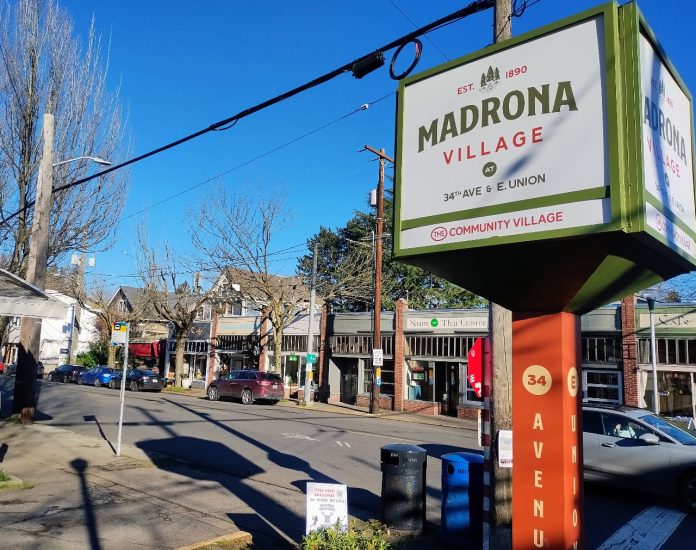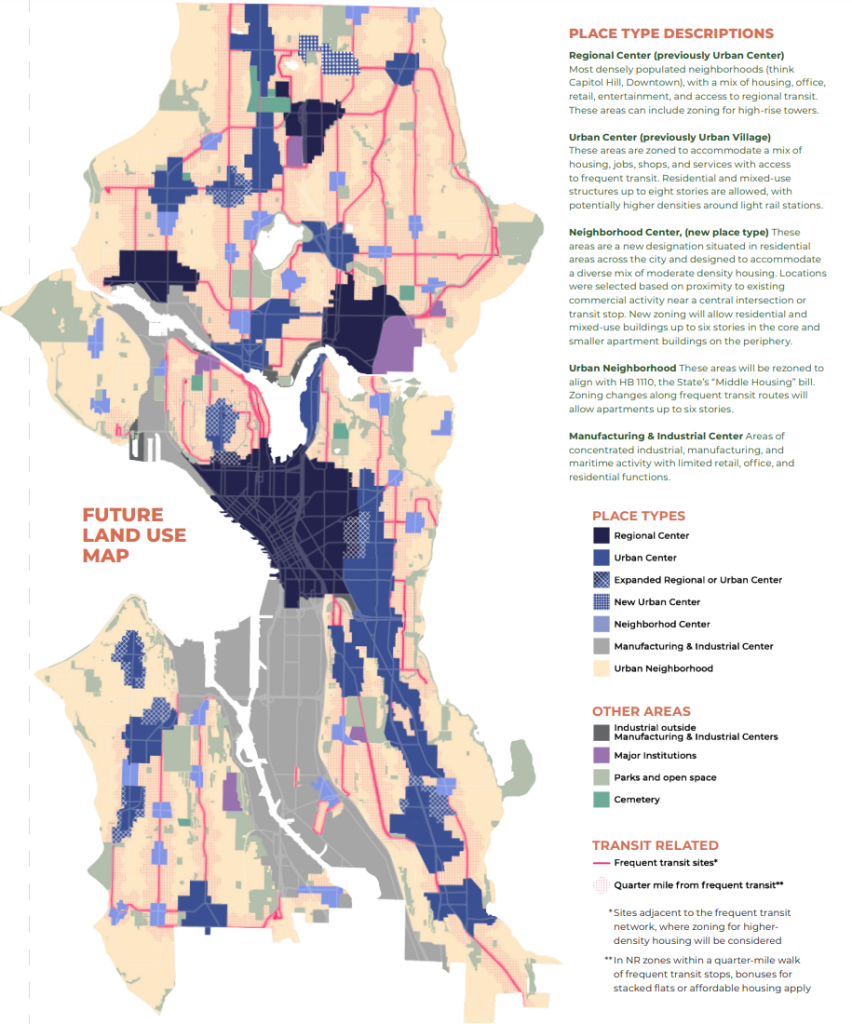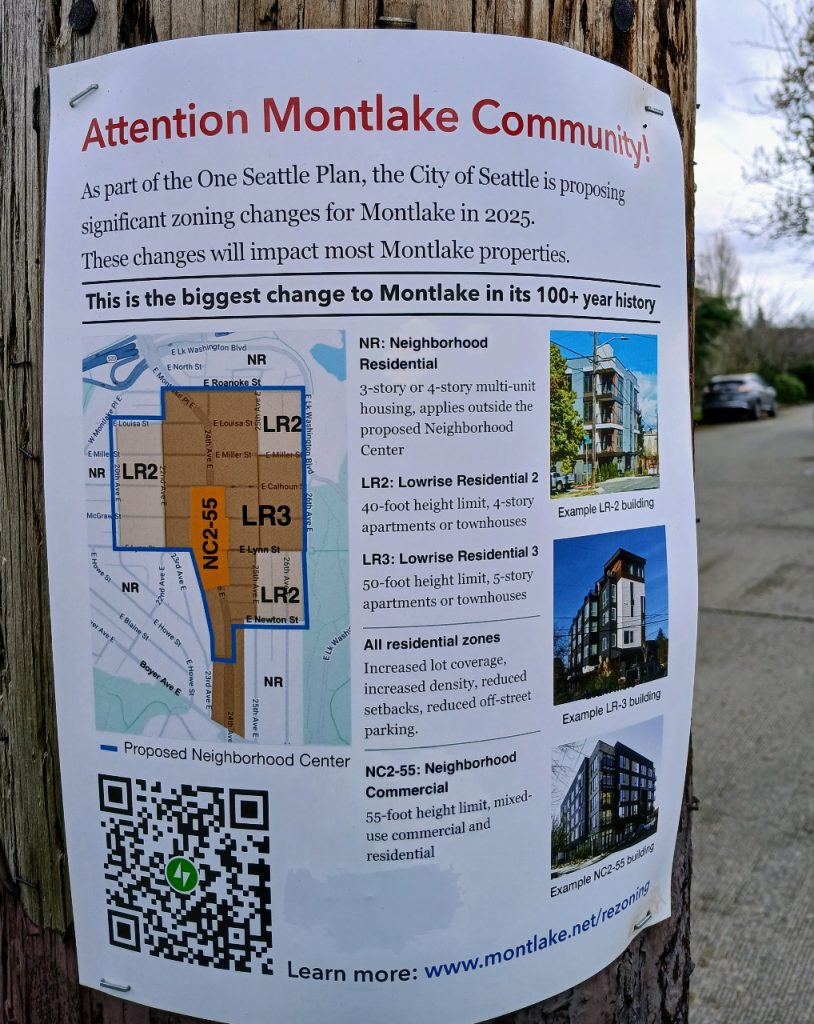
After the Mayor Bruce Harrell’s plan was late in arriving and a set of appeals delayed the Seattle City Council’s consideration of the full One Seattle Comprehensive Plan by two months, the most significant zoning changes included in the plan have now been fully pushed into next year, The Urbanist has confirmed. Despite the fact that all six of those appeals have now been dismissed and the council is free to proceed at its own pace, action to create capacity for additional housing via 30 new neighborhood centers and to allow additional density around frequent transit isn’t slated to happen until 2026.
Instead, the council will spend the rest of this spring adopting a temporary zoning ordinance, in order to comply with a early state-mandated June 30 deadline to allow four to six units of housing across all neighborhood residential lots in the city. That’s in spite of the fact that more than 10 weeks remaining to meet that deadline, and draft legislation has already been produced. Then, the council will turn around and spend the rest of the summer making those changes permanent, at the same time that it takes up the Comprehensive Plan as a policy and planning document.

The new timeline was revealed Wednesday by a hint dropped at the end of an otherwise sedate meeting of the council’s Comprehensive Plan Committee. Council central staff analyst Lish Whitson, responding to a question about an updated plan timeline from Councilmember Cathy Moore, revealed that work to update neighborhood residential zoning is expected to take until the fall budget season: traditionally the last major business that a council takes up in a calendar year.
“Hopefully this summer — before budget action, and we’re working on the schedule,” Whitson said.
Originally, the council had been scheduled to vote on phase two of the One Seattle Plan — which includes neighborhood centers and transit corridor upzones — by September. Phase three, which involves changes to the city’s existing urban centers like Capitol Hill and Northgate, will be pushed back even further as well. The “phase three” upzones were not a part of the original One Seattle draft proposal, but were added late in the process by the Mayor’s Office — much to planning director Rico Quirindongo’s chagrin.
Council spokesperson Brad Harwood, in response to a follow-up inquiry from The Urbanist confirmed that phase two of the One Seattle plan had been pushed. “You’re correct. At this time, it sounds like the only information available on Phase 2 is that it WILL be pushed to 2026,” Harwood wrote.
With this news, the council appears to be utilizing the delay brought by the appeals — which were dismissed relatively quickly thanks to reforms to the State Environmental Policy Act (SEPA) advanced at the state legislature in recent years — as a pretense to avoid major zoning changes. The neighborhood center upzones, which will bring additional allowed density to existing commercial hubs across the city, have proven to be one of the most controversial elements of the plan, with organized opposition to allowing new apartment buildings popping up in numerous neighborhoods, including Madrona, Maple Leaf, Green Lake, and Fauntleroy.

While the Seattle Hearing Examiner dismissed the six appeals from homeowner groups earlier this month, finding no merit with their legal arguments, the groups could potentially appeal the decision to a higher court. That may not happen until after passage, however.
Of all the additional housing set to be allowed by the final version of the One Seattle plan transmitted to council, over 78% — or approximately 94,000 units — is expected to be built as apartments or condominiums, the vast majority of which would be built in neighborhood centers or along transit corridors. Yet the city’s housing crisis is apparently not dire enough to prompt the council to accelerate adoption of those zoning changes.
The council’s slow timeline also stands in stark contrast with other cities around the region, which are also advancing legislation to comply with this summer’s state mandates. Bellevue’s Planning Commission has not yet made a recommendation to that city’s council, and yet interim legislation isn’t being considered there. Similarly, Renton’s City Council has not yet formally taken up legislation but appears likely to comply with the state deadline.
Delaying action into 2026 also sets up the possibility of new councilmembers voting on these zoning changes. Mark Solomon, appointed to fill a vacancy in District 2 left by the resignation of Tammy Morales early this year, will be replaced by new D2 representative — likely one that has made their desire for a more ambitious Comprehensive Plan plain, given the field.
Council President Sara Nelson, who has proudly touted her pro-housing bona fides after leading the charge for more housing in SoDo but has shied away from staking a position on the broader Comp Plan plan, faces a strong challenger in progressive policy wonk Dionne Foster. Alexis Mercedes Rinck also faces a reelection bid this year, but so far has not attracted a strong challenger.

Some councilmembers have publicly lamented that the plan did not arrive sooner from the Harrell Administration. Mayor Harrell delayed release of the draft plan and the Draft Environmental Impact Statement (EIS) that accompanied it as cabinet officials overhauled the original proposal from the Office of Planning and Community Development, decreasing the number of neighborhood centers and breadth of transit corridor upzones.
As the state’s June 30 middle housing deadline approach, the City split the zoning plan into two phases in hopes on speeding the way. That has meant the most impactful part of the plan won’t happen until more than a full calendar year after the Comprehensive Plan had officially been due at the end of 2024.
Meanwhile, housing advocates are calling on the council to take swift action now that no appeal stands in the way. The Complete Communities Coalition wrote a letter Thursday to the entire council, laying out a myriad of ways that they could make the plan even better, and encouraging the council to act swiftly. A broad coalition of organizations ranging from the Seattle Metropolitan Chamber of Commerce to Climate Solutions and the Transit Riders Union, the Complete Communities Coalition has been pushing for the most ambitious version of the One Seattle plan since it was in draft form. (The Urbanist is also a member of the group, via its advocacy team.)
“Seattle needs and deserves a bold Comprehensive Plan that allows for more homes in every neighborhood. We, the Complete Communities Coalition and the undersigned organizations— affordable housing developers, businesses, labor unions, environmental advocates, and
community groups—urge the City Council to put housing first in the One Seattle Plan,” the letter stated. “The status quo is failing Seattleites, and we need bold action to change course.”
“The dismissal of the anti-housing appeals of the One Seattle EIS is a major milestone —and now we have a clear path forward,” Patience Malaba, Executive Director of the Housing Development Consortium, said in a release timed with the letter. “To address our deep housing shortage, we need a bold, citywide plan that opens up more land for affordable housing, removes unnecessary barriers to development, and ensures that every neighborhood can be part of the solution. Seattleites living through this housing crisis can’t afford more delays.”
Ryan Packer has been writing for The Urbanist since 2015, and currently reports full-time as Contributing Editor. Their beats are transportation, land use, public space, traffic safety, and obscure community meetings. Packer has also reported for other regional outlets including Capitol Hill Seattle, BikePortland, Seattle Met, and PubliCola. They live in the Capitol Hill neighborhood of Seattle.


